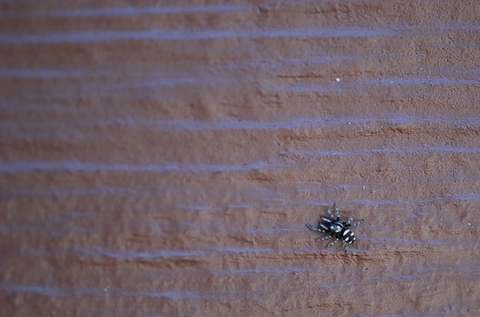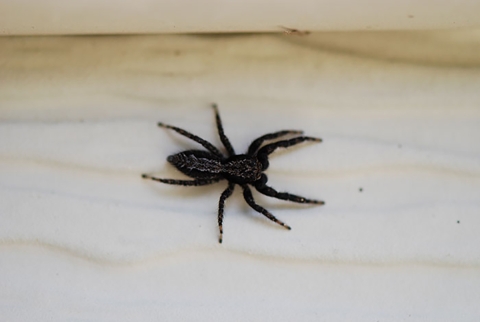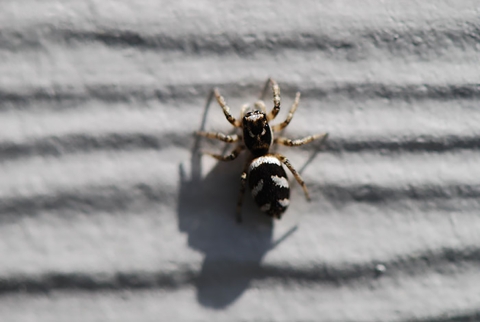Jumping spiders are small but often have very colorful, and even iridescent, markings. They don’t spin webs and wait to ensnare prey but instead actively patrol for food.
They love the sunshine and are very commonly seen prowling the outdoor walls of buildings. Their movements are quick and irregular, as though you are viewing them under a strobe light.
Their vision is among the very best in the invertebrate world; the front pair of eyes are greatly enlarged and provide excellent binocular vision, crucial to accurately judging distance. Sensing prey, they will slowly stalk closer in a cat-like manner, and once within leaping range, can jump many times the length of their own body. They first secure a silk thread, a sort of safety line, before the actual leap. The actual jump itself is extremely fast, so much so that your eye probably won’t even register a blur.
Their legs are tipped with hundreds of tiny hairs, each of which is further sub-divided into hundreds more even tinier hairs, each with a tiny foot at the end. This enables them to climb virtually any surface, and they will even climb straight up a vertical window, thanks to the traction gained from the microscopic imperfections in the surface of the glass.
They seem to be curious and to possess an awareness of being watched. They’ll respond by turning to face you and raise their head to in turn study you. They may back up to maintain a comfortable distance, but tend not to flee, but instead keeping facing you.
Males signal females by raising and waving their front legs in a sequence unique to the species; it reminds me of the guy who waves the orange flashlights to the pilot backing the plane out from the gate at the airport.
As kids, we’d use our approaching hand to back up zebra jumping spiders, a very common species, into an open jar, and quickly put the lid on. We’d then catch a housefly and put that in the jar. While I had expected the spider to wait until the fly landed and was thus stationary, I was both surprised and amazed when they would leap up and catch the fly right out of the air. They must have some sort of ability to mentally calculate the speed and trajectory of the target and then accordingly launch themselves on a path to intercept the fly. The fly would be flying around the jar in circles. You’d see the spider watch the fly buzzing about overhead, then seem to cock by its body back as though compressing an internal spring, and the next thing you knew the spider would have the fly locked in a death-grip on the bottom of the jar.
I’ve never tried this method, but I understand that jumping spiders will also chase the dot from a laser pointer, helpful if you are squeamish about using your hand to back them up into a waiting jar.
This story is part of our Open Spaces blog.






